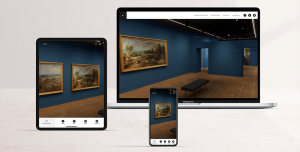Rubens: Reuniting the Great Landscapes on Vortic
For the first time in over two hundred years, The Wallace Collection reunited two of Peter Paul Rubens’ greatest landscapes in the exhibition ‘Rubens: Reuniting the Great Landscapes’.
Originally devised as companion pieces, A View of Het Steen in the Early Morning and The Rainbow Landscape were separated in 1803. Now, this historic reunion uses Vortic to propose two additional alternative hangings exploring how these works might have been displayed by Rubens himself.
The Rainbow Landscape and A View of Het Steen in the Early Morning are Rubens’ largest and greatest landscape works. These sweeping panoramas, painted for the artist’s pleasure during his final decade, are inspired by the beautiful countryside of Rubens’ estate in Brabant, with his own castle visible to the left of A View of Het Steen.
The works have been historically viewed as companion pieces or pendants (works intended to be viewed together), and travelled through a number of significant European collections before their separation in 1803. A special collaboration in the summer of 2021 between The Wallace Collection and The National Gallery, where A View of Het Steen in the Early Morning usually resides, offered the opportunity to see these great paintings together for the first time in over two hundred years. Now, thanks to the possibilities offered by Vortic’s digital exhibition technology, this historic reunion can continue to be enjoyed and studied beyond the physical show, and The Wallace Collection have created a unique exhibition on Vortic with multiple rooms to propose alternative hangings enabling viewers to further investigate the relationship between these two landmark works.
The Rainbow Landscape and A View of Het Steen in the Early Morning are Rubens’ largest and greatest landscape works. These sweeping panoramas, painted for the artist’s pleasure during his final decade, are inspired by the beautiful countryside of Rubens’ estate in Brabant, with his own castle visible to the left of A View of Het Steen.
Exploring alternative hangs
While the paintings were hung opposite one another at The Wallace Collection’s exhibition in London, there remains a debate as to how these landscapes would have originally been displayed in Rubens’ own residence. Presenting the exhibition on Vortic allows The Wallace Collection to explore alternative hangings of the two paintings, and to raise questions about the formal relationship between the two works and how this reflects on Rubens’ late practice.

The opposing configuration was chosen to emphasise the apparent shared light source in the paintings – the shadows cast by the trees and figures all fall in the same direction, and the same quality of sunlight appears to illuminate both scenes. However, there is an alternative argument that the paintings were intended to be hung side by side, seeming to form a continuous panorama in front of the viewer – either taking the eye from Rubens’ Het Steen Castle across the landscape to the forest, or alternatively having the forest at the centre of the scene with its unifying rich greenery.

With Vortic the show’s curatorial team are able to present the works in all three potential scenarios. The mystery of how these companion works were intended to be viewed remains to be solved, but using Vortic allows viewers to contemplate the landscapes and artistic approach from different perspectives.
Further, the digital recreation of the exhibition creates a high-fidelity archival record, so that the works can continue to be viewed as a pair from anywhere in the world, and long after the exhibition closes. In the digital gallery, specially designed to recreate The Wallace Collection’s own galleries, viewers can get closer than ever to these magnificent works, allowing for private and engaging moments of contemplation away from the crowd.
‘Rubens: Reuniting The Great Landscapes’ brought these two paintings together for the first time in over 200 years; now the digital exhibition will allow viewers to continue to enjoy and study these works indefinitely.
Click to visit the exhibition on Vortic.





